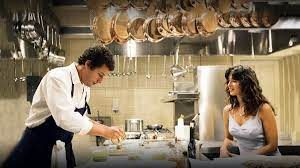Film Project: By Nick Katona
The film Spanglish begins with Flor Moreno and her daughter Cristina leaving from Mexico and arriving in Los Angeles in an attempt to have a better quality of life. Flor and her sister, Monica, went to John and Deborah Clasky’s residence so Flor could interview for a position at their home as a maid. They arrive on a deal for Flor to get paid $650 for the summer. The Clasky’s are a well-off family as a result of John’s status as a gourmet chef. Some challenges to this situation quickly arose as there was an obvious language barrier that made communication rather difficult. With Flor speaking no English and the Clasky’s not knowing any Spanish, it made things difficult. In addition, it was apparent that the Clasky’s were having trouble parenting their children, and they visibly had issues as well. After a couple weeks of Flor being the maid there, Deborah asks Flor and her daughter if they want to stay at their home for the summer, for convenience sake. Flor accepts, and she and Cristina move in shortly after. Deborah quickly becomes fond of Cristina as they went out shopping and did other things together. Flor didn’t care for this behavior, and she appeared to quickly take a dislike to Deborah. Eventually Flor learns to speak English, finally breaking that language barrier between herself and the Clasky’s. It becomes obvious that John likes this and is clearly giving Flor the eye as she gives it right back. While they are beginning to secretly grow quite fond of each other, a scene showed Deborah getting in another man’s convertible and telling him that he’s “trouble”. From there on it is evident that she is cheating on him. After her being out very late all the time, John caught on, and eventually the truth came out. John left the house moments after that with Flor, and took her to his restaurant, where he cooked her an entree as well as dessert. They went on to share many gazes throughout the night, ended up kissing, and Flor expressed her love for John, and then quickly ran out. She returned to the house later to tell Cristina that they were leaving and going back home. She also had to inform Cristina that she had to leave her private school. Cristina was distraught about this situation, but through this her mother taught her the importance of family, and that family should be prioritized over everything else.

Food plays an important role in this film. The first way in which this plays an important role is the fact that John is able to make a great living for himself and his family through being a gourmet chef. Secondly, food appears spontaneously in a couple scenes in the movie. Lastly, food showed up in the scene where John took Flor to his restaurant to cook her food. In one way, shape, or form, food shows up throughout the movie and is one of the underlying foundations of the film.

One of the main themes that is represented in this film that is part of the biocultural framework is Cuisine. Cuisine plays a major role because of John’s high status as a gourmet chef. He specializes in making high quality food that is very representative of good cuisine. For example, during the scene in the movie in which he is simply making a breakfast sandwich, it was apparent that the sandwich was made from skill, experience, and care. Another part of the biocultural framework that is represented in this film is the socioeconomic environment. Once again, the upper class status of John and his family give them enhanced access to other high class people, high quality ingredients for his restaurant, and other resources that set him apart from other social classes. A third portion of the biocultural framework that shows up in the film is technology. There was a scene in the film, on the first day that Flor started, that shows Deborah asking Flor to make some coffee, as she points to their extravagant coffee maker. It looked very advanced, and the look on Flor’s face when she first saw it indicated that she had never seen something quite like that in her life. This showed the separation of class and the associated ability to have access to better technology and other resources. This also heavily ties into cultural capital as the “taste, manners, and social skills” tie into the social class status of the Clasky family.

In terms of food and gender identity, this film aligns with the the statistical fact that high-profile chefs are typically chefs, which is the case here as well. However, in the scene where John cooks just for Flor (Spanglish, 1:40:42), this does not fit the typical stereotype of gender roles as they relate to food. According to slide 39 of the “Food and Identity” section, “women still do most of the feeding work in the U.S.: planning, preserving, preparing, serving.” The gender roles were reversed here since John went out of his way to make dinner and dessert for Flor. By John cooking for her, it was definitely a term of endearment that was representative of food as material and symbolic. Lastly, taste is represented in the film. There is a scene in which Flor arrives back at the Clasky residence and Bernice hands her was appear to be a muffin or some other type of bread. Flor took bite and her facial expression was very telling of just how delicious and tasty that food was.

My informed opinion on the film is that it is a great film overall with an intriguing storyline. One of its strengths is that there are several good lessons that can be learned from the film. One of these occurs when Flor is fed up with being at the Clasky house because of instances happening like Deborah taking Cristina to get her hair dyed behind Flor’s back. Flor informs John that she is going to quit, but he convinces her to stay instead. When speaking about this with Flor, John said, “You can’t do this to her. You don’t want that guilt,” (Spanglish, 1:04:32). This is a lesson that can be translated to really anyone else’s life. When things get difficult, sometimes we just want to give in and quit. Sometime the situation is more important than our desire to quit, and therefore we have to keep going. Another strength of the film is the way that relationships were built throughout the film, particularly between Flor and John. This is evident, once again, in the scene where John and Flor were sharing a meal together at his restaurant. While narrating the film, Cristina said, “My mother has referred to that night at the restaurant as the conversation of her life,” (Spanglish, 1:49:20). This exemplifies how the shared experience of eating food can make for a great opportunity to connect with one or more people on a deep level. This was a great film and I did not notice any particular weaknesses.
References
Ansel, J. (Producer), & Brooks, J. (Director). (2004). Spanglish [Motion Picture]. United States: Columbia Pictures Industries.
Spanglish [Online Image]. (2004).https://www.sonypictures.com/movies/spanglish
Spanglish [Online Image]. (2004). https://brandontalksmovies.com/2018/08/14/spanglish/
Spanglish sandwich [Online Image]. (2004). https://www.bigoven.com/recipe/spanglish-sandwich/457865
Watch Spanglish [Online Image] (2004). https://www.amazon.com/Spanglish-Aimee-Garcia/dp/B000I9X50U
Spanglish [Online Image] (2004). https://letterboxd.com/film/spanglish/